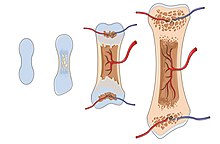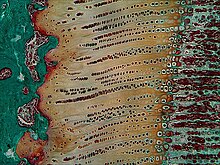Ossification
This article has multiple issues. Please help improve it or discuss these issues on the talk page. (Learn how and when to remove these template messages)
|
Ossification (also called osteogenesis or bone mineralization) in
In
The exact mechanisms by which
| Time period[3] | Bones affected[3] |
|---|---|
| Third month of fetal development | Ossification in long bones beginning |
| Fourth month | Most primary ossification centers have appeared in the diaphyses of bone. |
| Birth to 5 years | Secondary ossification centers appear in the epiphyses |
| 5 years to 12 years in females, 5 to 14 years in males | Ossification is spreading rapidly from the ossification centers and various bones are becoming ossified. |
| 17 to 20 years | Bone of upper limbs and scapulae becoming completely ossified
|
| 18 to 23 years | Bone of the lower limbs and os coxae become completely ossified
|
| 23 to 26 years | Bone of the vertebrae become completely ossified
|
| By 25 years | Nearly all bones are completely ossified |
Intramembranous ossification
This section needs expansion. You can help by adding to it. (January 2021) |
Intramembranous ossification forms the flat bones of the skull, mandible and hip bone.
Endochondral ossification

Endochondral ossification is the formation of long bones and other bones. This requires a hyaline cartilage precursor. There are two centers of ossification for endochondral ossification.
The primary center
In long bones, bone tissue first appears in the diaphysis (middle of shaft). Chondrocytes multiply and form trebeculae. Cartilage is progressively eroded and replaced by hardened bone, extending towards the epiphysis. A perichondrium layer surrounding the cartilage forms the periosteum, which generates osteogenic cells that then go on to make a collar that encircles the outside of the bone and remodels the medullary cavity on the inside.
The nutrient artery enters via the nutrient foramen from a small opening in the diaphysis. It invades the primary center of ossification, bringing osteogenic cells (osteoblasts on the outside, osteoclasts on the inside.) The canal of the nutrient foramen is directed away from more active end of bone when one end grows more than the other. When bone grows at same rate at both ends, the nutrient artery is perpendicular to the bone.
Most other bones (e.g. vertebrae) also have primary ossification centers, and bone is laid down in a similar manner.
Secondary centers
The secondary centers generally appear at the epiphysis. Secondary ossification mostly occurs after birth (except for distal femur and proximal tibia which occurs during 9th month of fetal development). The epiphyseal arteries and osteogenic cells invade the epiphysis, depositing osteoclasts and osteoblasts which erode the cartilage and build bone, respectively. This occurs at both ends of long bones but only one end of digits and ribs.

Evolution
Several hypotheses have been proposed for how bone evolved as a structural element in
See also
- Dystrophic calcification
- Mechanostat, a model describing ossification and bone loss
- Ossicone, the horn-like (or antler-like) protuberances on the heads of giraffes and related species
- Osteogenesis imperfecta, a juvenile bone disease
- Fibrodysplasia ossificans progressiva, an extremely rare genetic disease which causes fibrous tissue (muscle, tendon, ligament etc.) to ossify when damaged
- Primrose syndrome, a rare genetic disease in which cartilage becomes ossified.
References
- ^ "bone formation | Definition & Physiology". Encyclopedia Britannica. Retrieved 2021-01-22.
- PMID 17572649.
- ^ a b Emily Morey-Holton. "Predicting Height from the Length of Limb Bones". Examining Effects of Space Flight on the Skeletal System. Moffett Field, California: NASA Ames Research Center. Archived from the original on 2012-03-01.
- S2CID 10933086.
